A Mimic Model Approach for Impact Assessment of Mining Activities on Sustainable Development Indicators
Abstract
:1. Introduction
2. Materials and Methods
2.1. Qualitative Study
2.2. Quantitative Study
3. Results and Discussion
3.1. Qualitative Research Findings
3.2. Quantitative Research Findings
4. Conclusions
Author Contributions
Funding
Informed Consent Statement
Data Availability Statement
Conflicts of Interest
References
- Worrall, R.; Neil, D.; Brereton, D.; Mulligan, D. Towards a sustainability criteria and indicators framework for legacy mine land. J. Clean. Prod. 2009, 17, 1426–1434. [Google Scholar] [CrossRef]
- Feng, Q.; Yang, W.; Wen, S.; Wang, H.; Zhao, W.; Han, G. Flotation of copper oxide minerals: A review. Int. J. Min. Sci. Technol. 2022, 32, 1351–1364. [Google Scholar]
- Davis, G.A.; Tilton, J.E. Should Developing Countries Renounce Mining? A Perspective on the Debate. Rep. Prep. Int. Counc. Min. Met. (ICMM). London ICMM. 2002. Available online: https://www.semanticscholar.org/paper/SHOULD-DEVELOPING-COUNTRIES-RENOUNCE-MINING-A-ON-Davis-Tilton/e5c3bfd21912e8547be2041381e90a0d0582d4b9 (accessed on 7 December 2022).
- Association, N.M. The Economic Contributions of US Mining; Natl. Min. Assoc: Washington, DC, USA, 2014. [Google Scholar]
- Mbilima, F. Extractive industries and local sustainable development in Zambia: The case of corporate social responsibility of selected metal mines. Resour. Policy 2021, 74, 101441. [Google Scholar] [CrossRef]
- Asr, E.T.; Kakaie, R.; Ataei, M.; Mohammadi, M.R.T. A review of studies on sustainable development in mining life cycle. J. Clean. Prod. 2019, 229, 213–231. [Google Scholar] [CrossRef]
- WCED, S.W.S. World commission on environment and development. Our Common Futur. 1987, 17, 1–91. [Google Scholar]
- Tost, M.; Hitch, M.; Chandurkar, V.; Moser, P.; Feiel, S. The state of environmental sustainability considerations in mining. J. Clean. Prod. 2018, 182, 969–977. [Google Scholar] [CrossRef]
- Hilson, G.; Murck, B. Sustainable development in the mining industry: Clarifying the corporate perspective. Resour. Policy 2000, 26, 227–238. [Google Scholar] [CrossRef]
- Moradi, G.; Osanloo, M. Prioritizing sustainable development criteria affecting open pit mine design: A mathematical model. Procedia Earth Planet. Sci. 2015, 15, 813–820. [Google Scholar] [CrossRef]
- Guo, W.; Guo, M.; Tan, Y.; Bai, E.; Zhao, G. Sustainable development of resources and the environment: Mining-induced eco-geological environmental damage and mitigation measures—A case study in the Henan coal mining area, China. Sustainability 2019, 11, 4366. [Google Scholar] [CrossRef]
- De Valck, J.; Williams, G.; Kuik, S. Does coal mining benefit local communities in the long run? A sustainability perspective on regional Queensland, Australia. Resour. Policy 2021, 71, 102009. [Google Scholar] [CrossRef]
- Monjezi, M.; Shahriar, K.; Dehghani, H.; Samimi Namin, F. Environmental impact assessment of open pit mining in Iran. Environ. Geol. 2009, 58, 205–216. [Google Scholar] [CrossRef]
- Azapagic, A. Developing a framework for sustainable development indicators for the mining and minerals industry. J. Clean. Prod. 2004, 12, 639–662. [Google Scholar] [CrossRef]
- Marimuthu, R.; Sankaranarayanan, B.; Ali, S.M.; de Sousa Jabbour, A.B.L.; Karuppiah, K. Assessment of key socio-economic and environmental challenges in the mining industry: Implications for resource policies in emerging economies. Sustain. Prod. Consum. 2021, 27, 814–830. [Google Scholar] [CrossRef]
- Kitula, A.G.N. The environmental and socio-economic impacts of mining on local livelihoods in Tanzania: A case study of Geita DistrictExploring the impacts of coal mining on host communities in Shanxi, China—Using subjective data. J. Clean. Prod. 2006, 14, 405–414. [Google Scholar] [CrossRef]
- Que, S.; Wang, L.; Awuah-Offei, K.; Chen, Y.; Yang, W. The status of the local community in mining sustainable development beyond the triple bottom line. Sustainability 2018, 10, 1749. [Google Scholar] [CrossRef]
- Erzurumlu, S.S.; Erzurumlu, Y.O. Sustainable mining development with community using design thinking and multi-criteria decision analysis. Resour. Policy 2015, 46, 6–14. [Google Scholar] [CrossRef]
- Ghorbani, Y.; Kuan, S.H. A review of sustainable development in the Chilean mining sector: Past, present and future. Int. J. Min. Reclam. Environ. 2017, 31, 137–165. [Google Scholar] [CrossRef]
- Mancini, L.; Sala, S. Social impact assessment in the mining sector: Review and comparison of indicators frameworks. Resour. Policy 2018, 57, 98–111. [Google Scholar] [CrossRef]
- Bury, J. migrants: Transnational mining and migration patterns in the P.A. Mining migrants: Transnational mining and migration patterns in the Peruvian Andes. Prof. Geogr. 2007, 59, 378–389. [Google Scholar] [CrossRef]
- Erwana, F.; Dewi, K.; Rahardyan, B. Study of socio-economic and environment impacts of inconventional tin mining (a case study: Bangka Barat District of Bangka Belitung Province). In Proceedings of the Third Joint Seminar of Japan and Indonesia Environmental Sustainability and Disaster Prevention (3rd ESDP-2015); Institut Teknologi Bandung: Jawa Barat, Indonesia, 2015; Volume 25. [Google Scholar]
- Mojarradi, G.; Rezaei, R.; Ketabi, A. Negative impacts of mine exploitations on rural regions of Tekab Township. Min. Eng. 2016, 7, 57–66. [Google Scholar]
- Li, Q.; Stoeckl, N.; King, D.; Gyuris, E. Exploring the impacts of coal mining on host communities in Shanxi, China—Using subjective data. Resour. Policy 2017, 53, 125–134. [Google Scholar] [CrossRef]
- Farahani, H.; Bayazidi, S. Mining industry impact on environmental sustainability, economic growth, social interaction, and public health: An application of semi-quantitative mathematical approach. Resour. Policy 2018, 55, 972. [Google Scholar]
- Yang, X.; Ho, P. Conflict over mining in rural China: A comprehensive survey of intentions and strategies for environmental activism. Sustainability 2018, 10, 1669. [Google Scholar] [CrossRef]
- Kumah, A. Sustainability and gold mining in the developing world. J. Clean. Prod. 2006, 14, 315–323. [Google Scholar] [CrossRef]
- Leuenberger, A.; Kihwele, F.; Lyatuu, I.; Kengia, J.T.; Farnham, A.; Winkler, M.S.; Merten, S. Gendered health impacts of industrial gold mining in northwestern Tanzania: Perceptions of local communities. Impact Assess. Proj. Apprais. 2021, 39, 183–195. [Google Scholar] [CrossRef]
- Adibi, N.; Ataee-pour, M.; Rahmanpour, M. Integration of sustainable development concepts in open pit mine design. J. Clean. Prod. 2015, 108, 1037–1049. [Google Scholar] [CrossRef]
- Kvale, S.; Brinkmann, S. Interviews: Learning the Craft of Qualitative Research Interviewing; Sage: Thousand Oaks, CA, USA, 2009; ISBN 0761925422. [Google Scholar]
- Irandoost, S.F.; Ziapour, A.; Gharehghani, M.A.M.; Azar, F.E.F.; Soofizad, G.; Khosravi, B.; Solhi, M. Experiences and challenges of Prostitute Women in Iran: A phenomenological qualitative study. Heliyon 2020, 6, e05649. [Google Scholar]
- Slišković, A. Seafarers’ well-being in the context of the COVID-19 pandemic: A qualitative study. Work 2020, 67, 799–809. [Google Scholar] [CrossRef]
- Yoosefi Lebni, J.; Ziapour, A.; Mehedi, N.; Irandoost, S.F. The role of clerics in confronting the COVID-19 crisis in Iran. J. Relig. Health 2021, 60, 2387–2394. [Google Scholar] [CrossRef]
- Lebni, J.Y.; Irandoost, S.F.; Dehghan, A.A.; Ziapour, A.; Khosravi, B.; Mehedi, N. Exploring the reasons for women to engage in sex work in Tehran, Iran: A qualitative study. Heliyon 2021, 7, e08512. [Google Scholar] [CrossRef]
- Kuske, S.; Borgmann, S.O.; Wolf, F.; Bleck, C. Emotional Safety in the Context of Dementia: A Multiperspective Qualitative Study. J. Alzheimer’s Dis. 2021, 79, 355–375. [Google Scholar] [CrossRef]
- Belgrave, L.L.; Seide, K. Coding for Grounded Theory. InThe SAGE Handbook of Current Developments in Grounded Theory; Sage Publications, Inc.: Thousand Oaks, CA, USA, 2019; pp. 167–185. [Google Scholar]
- Strauss, A.; Corbin, J. Basics of Qualitative Research Techniques; Sage Publications, Inc.: Thousand Oaks, CA, USA, 1998. [Google Scholar]
- Cascio, M.A.; Lee, E.; Vaudrin, N.; Freedman, D.A. A team-based approach to open coding: Considerations for creating intercoder consensus. Field Methods 2019, 31, 116–130. [Google Scholar] [CrossRef]
- Williams, M.; Moser, T. The art of coding and thematic exploration in qualitative research. Int. Manag. Rev. 2019, 15, 45–55. [Google Scholar]
- Royal, K. “Face validity” is not a legitimate type of validity evidence! Am. J. Surg. 2016, 212, 1026–1027. [Google Scholar] [CrossRef] [PubMed]
- Ghaziasgar, M.; Vahdat, S.; Hesam, S. Development and Psychometric “Evaluationof Hospital Cost Management Scale”. J. Heal. Promot. Manag. 2020, 9, 25–33. [Google Scholar]
- Lawshe, C.H. A quantitative approach to content validity. Pers. Psychol. 1975, 28, 563–575. [Google Scholar] [CrossRef]
- Brown, J.D. The Cronbach Alpha Reliability Estimate. JALT Test. Eval. SIG Newsl. 2002, pp. 17–18. Available online: http://jalt.org/test/PDF/Brown13.pdf (accessed on 7 December 2022).
- Kang, H. Sample size determination and power analysis using the G* Power software. J. Educ. Eval. Health Prof. 2021, 18, 17. [Google Scholar] [CrossRef] [PubMed]
- Lynn, M.R. Determination and quantification of content validity. Nurs. Res. 1986, 35, 382–386. [Google Scholar] [CrossRef]
- Miller, K.A.; Thompson, K.F.; Johnston, P.; Santillo, D. An overview of seabed mining including the current state of development, environmental impacts, and knowledge gaps. Front. Mar. Sci. 2018, 4, 418. [Google Scholar] [CrossRef]
- Kahhat, R.; Parodi, E.; Larrea-Gallegos, G.; Mesta, C.; Vázquez-Rowe, I. Environmental impacts of the life cycle of alluvial gold mining in the Peruvian Amazon rainforest. Sci. Total Environ. 2019, 662, 940–951. [Google Scholar] [CrossRef]
- Mabey, P.T.; Li, W.; Sundufu, A.J.; Lashari, A.H. Environmental impacts: Local perspectives of selected mining edge communities in Sierra Leone. Sustainability 2020, 12, 5525. [Google Scholar] [CrossRef]
- Ogbonna, P.C.; Nzegbule, E.C.; Okorie, P.E. Environmental impact assessment of coal mining at Enugu, Nigeria. Impact Assess. Proj. Apprais. 2015, 33, 73–79. [Google Scholar] [CrossRef]
- Mohsin, M.; Zhu, Q.; Naseem, S.; Sarfraz, M.; Ivascu, L. Mining industry impact on environmental sustainability, economic growth, social interaction, and public health: An application of semi-quantitative mathematical approach. Processes 2021, 9, 972. [Google Scholar] [CrossRef]
- Shoko, M.; Mwitwa, J. Socio-economic impact of small scale emerald mining on local community livelihoods: The case of Lufwanyama district. Int. J. Educ. Res. 2015, 3, 14. [Google Scholar]
- Gueye, E.H.M.; Badri, A.; Boudreau-Trudel, B. Sustainable development in the mining industry: Towards the development of tools for evaluating socioeconomic impact in the Canadian. Environ. Dev. Sustain. 2021, 23, 6576–6602. [Google Scholar] [CrossRef]
- Jurzina, T.; Egorova, N.; Zaruba, N.; Kosinskij, P. Tools of realization of social responsibility of industrial business for sustainable socio-economic development of mining region’s rural territory, in E3S Web of Conferences. EDP Sci. 2017, 21, 4010. [Google Scholar] [CrossRef]
- Kemp, D.; Keenan, J. Why gender Matters: A Resource Guide for Integrating Gender Considerations into Communities Work at Rio Tinto; Rio Tinto: Melbourne, VIC, Australia, 2010. [Google Scholar]
- Al Rawashdeh, R.; Campbell, G.; Titi, A. The socio-economic impacts of mining on local communities: The case of Jordan. Extr. Ind. Soc. 2016, 3, 494–507. [Google Scholar] [CrossRef]
- Pokorny, B.; von Lübke, C.; Dayamba, S.D.; Dickow, H. All the gold for nothing? Impacts of mining on rural livelihoods in Northern Burkina Faso. World Dev. 2019, 119, 23–39. [Google Scholar] [CrossRef]
- Lei, K.; Pan, H.; Lin, C. A landscape approach towards ecological restoration and sustainable development of mining areas. Ecol. Eng. 2016, 90, 320–325. [Google Scholar] [CrossRef]
- Si, H.; Bi, H.; Li, X.; Yang, C. Environmental evaluation for sustainable development of coal mining in Qijiang, Western China. Int. J. Coal Geol. 2010, 81, 163–168. [Google Scholar] [CrossRef]
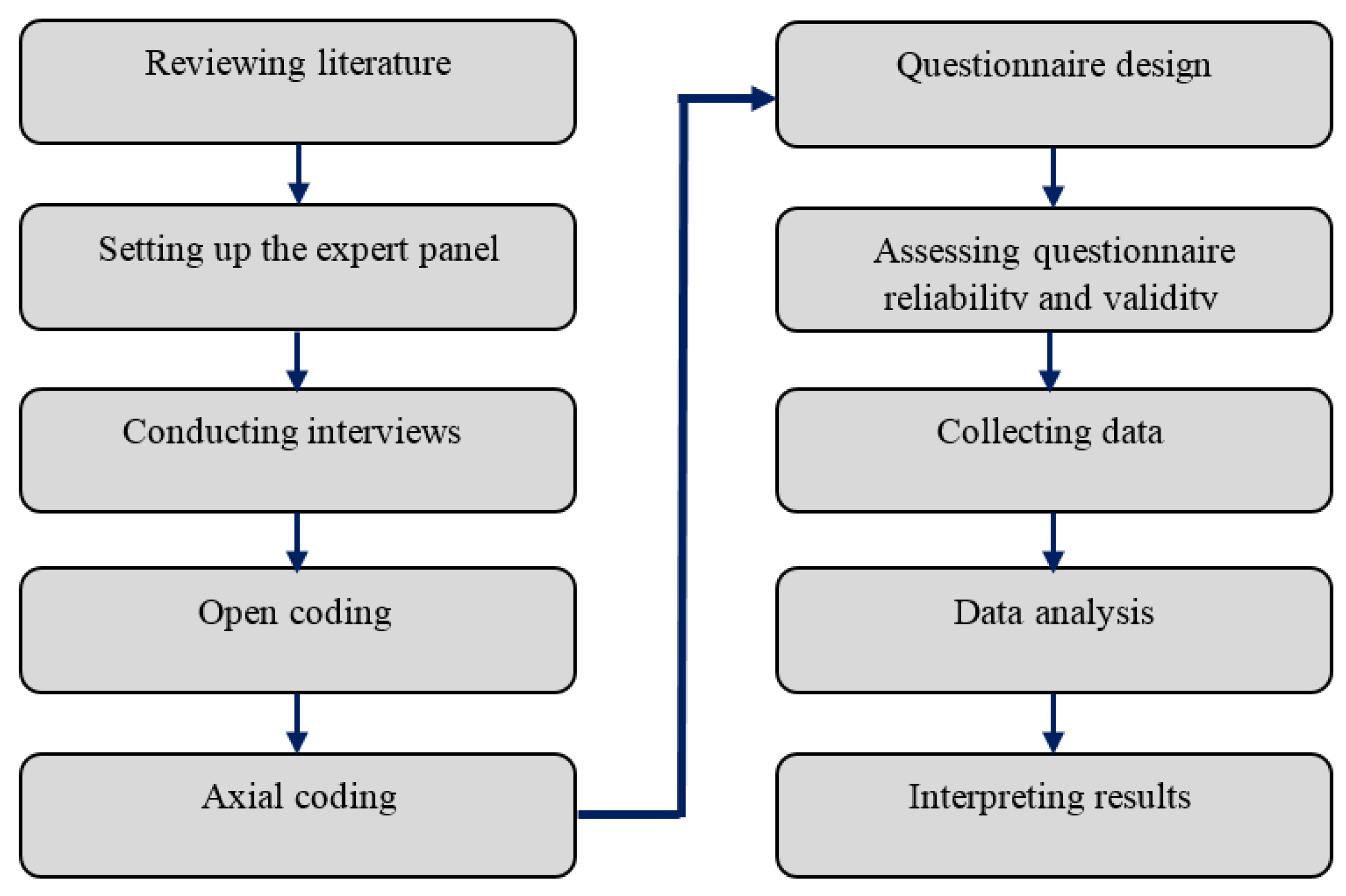
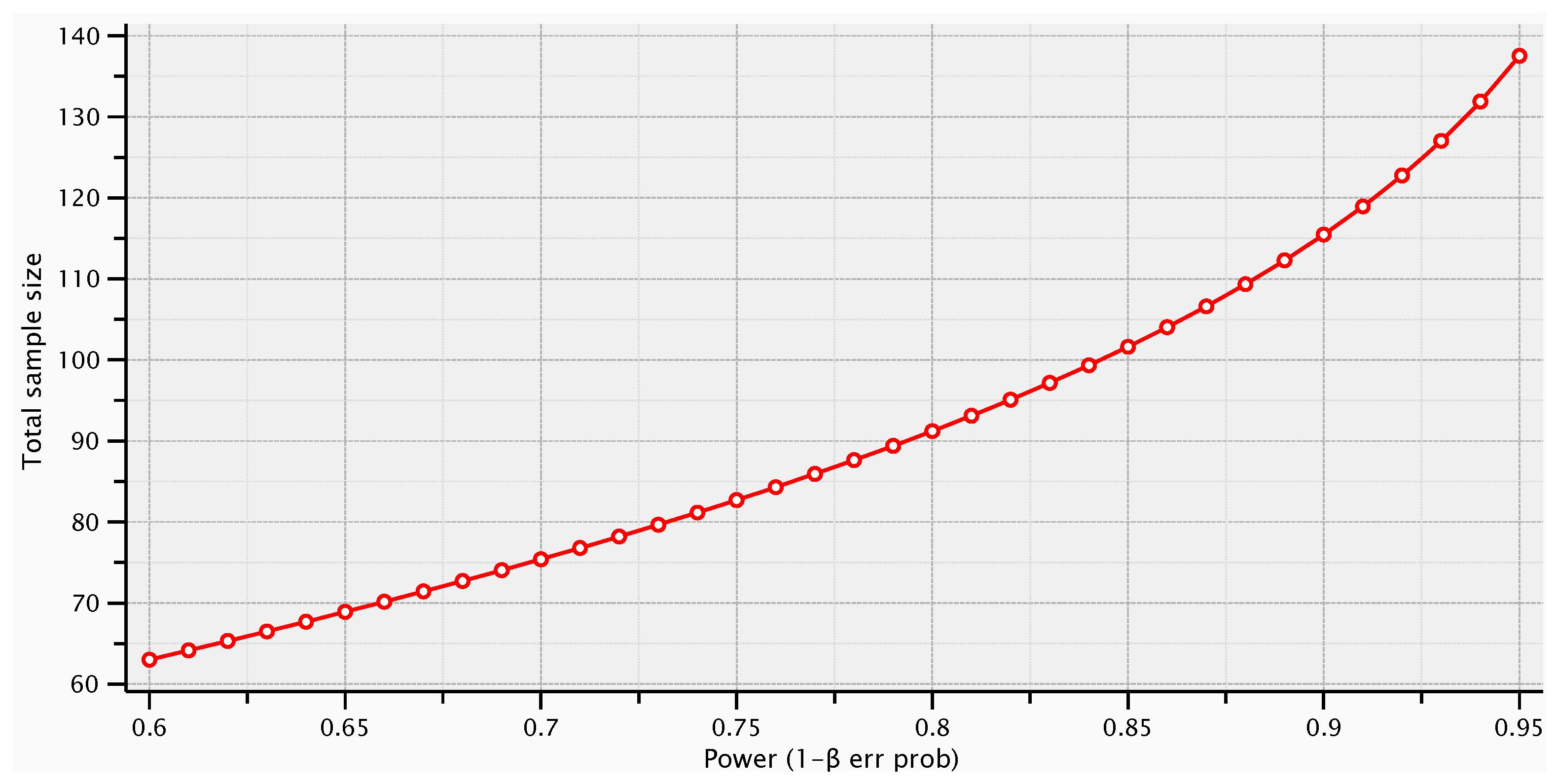
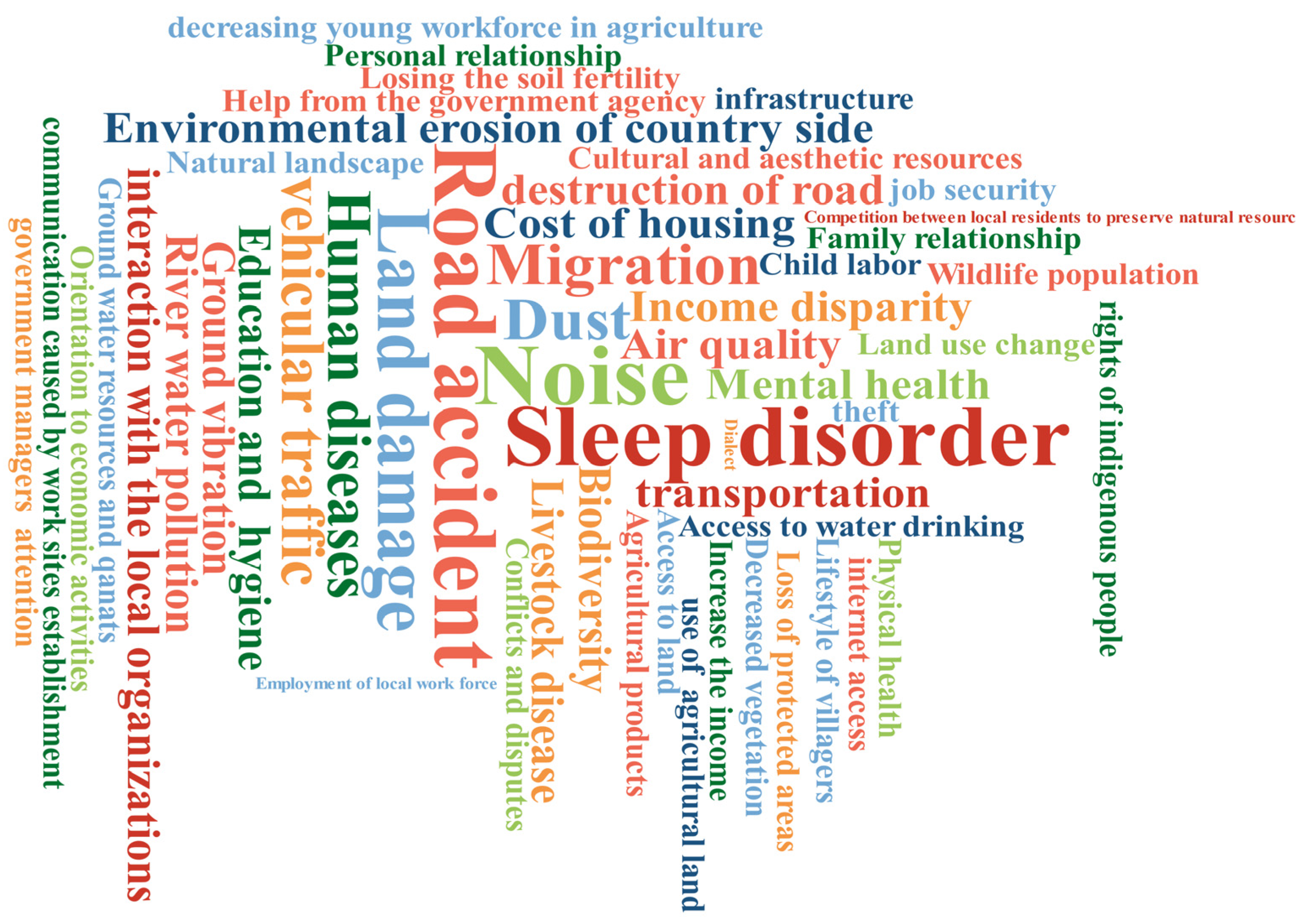
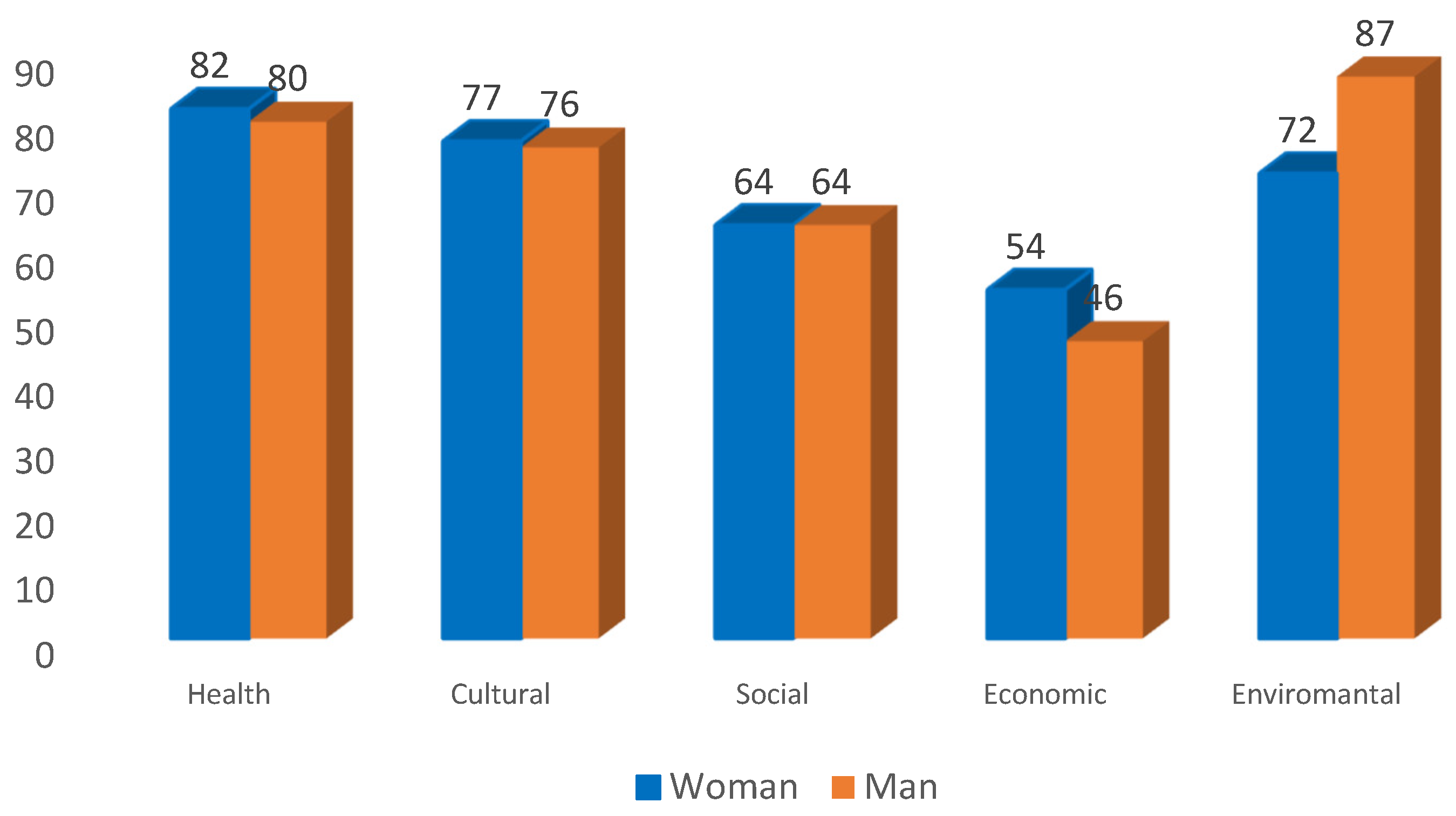

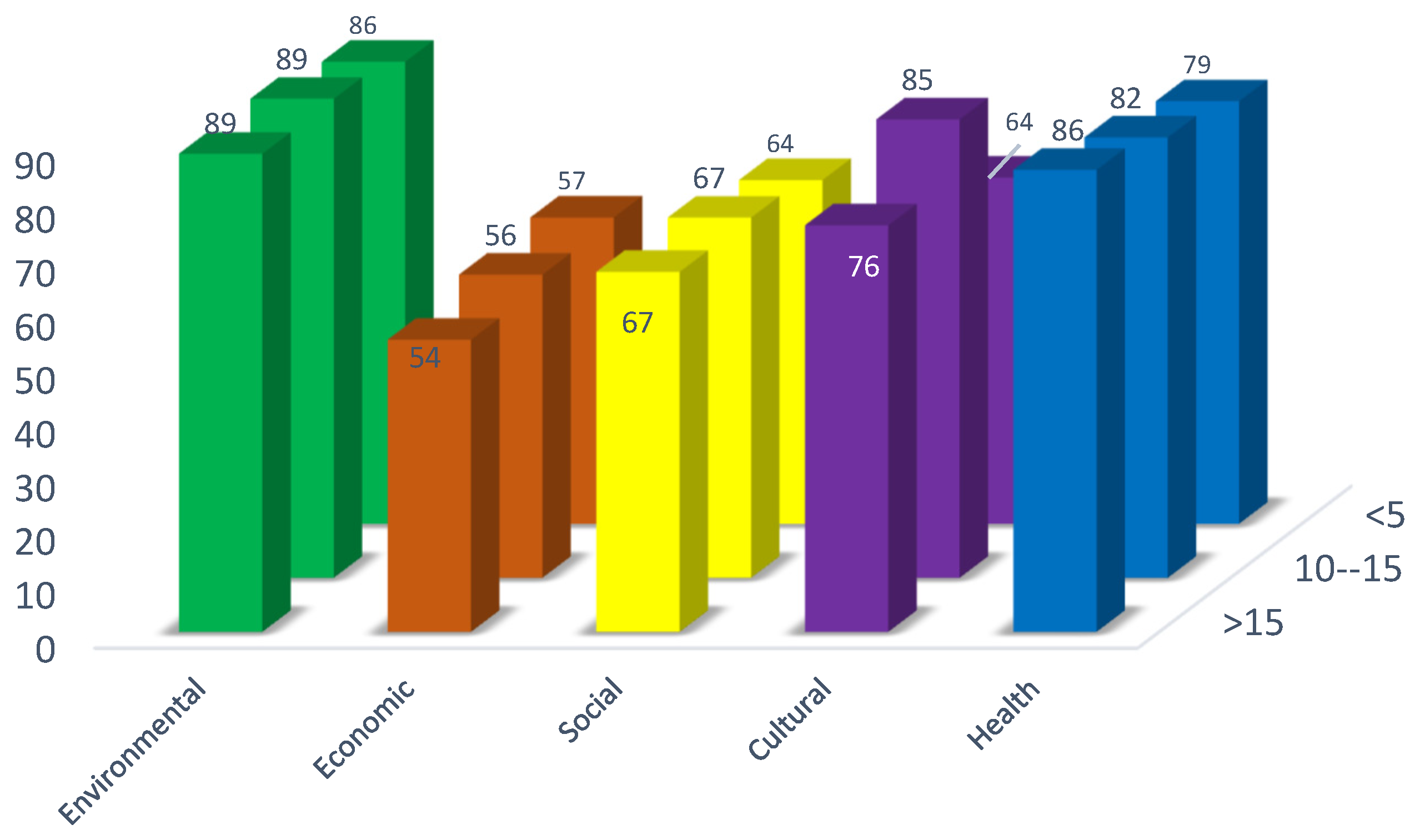
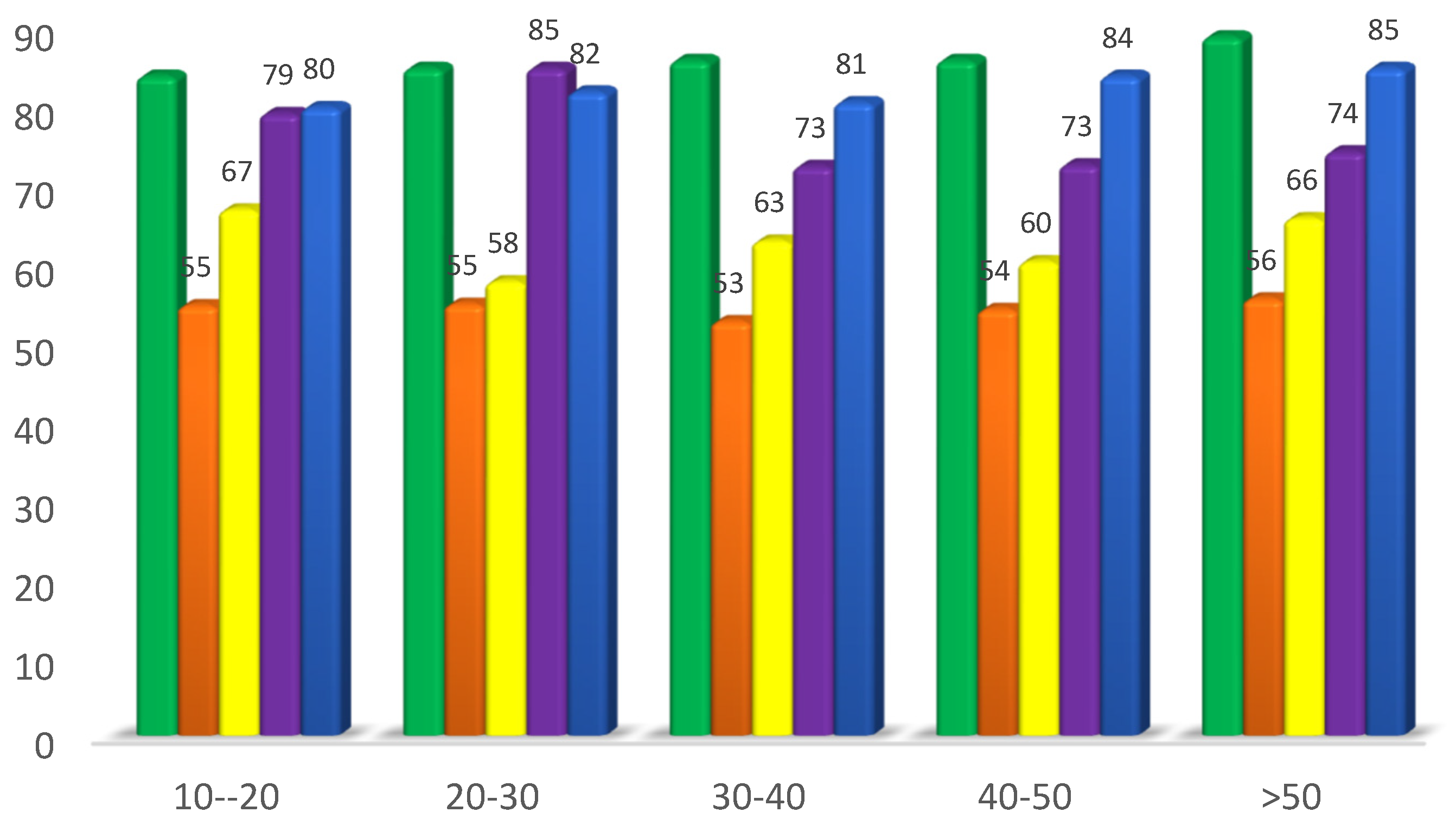
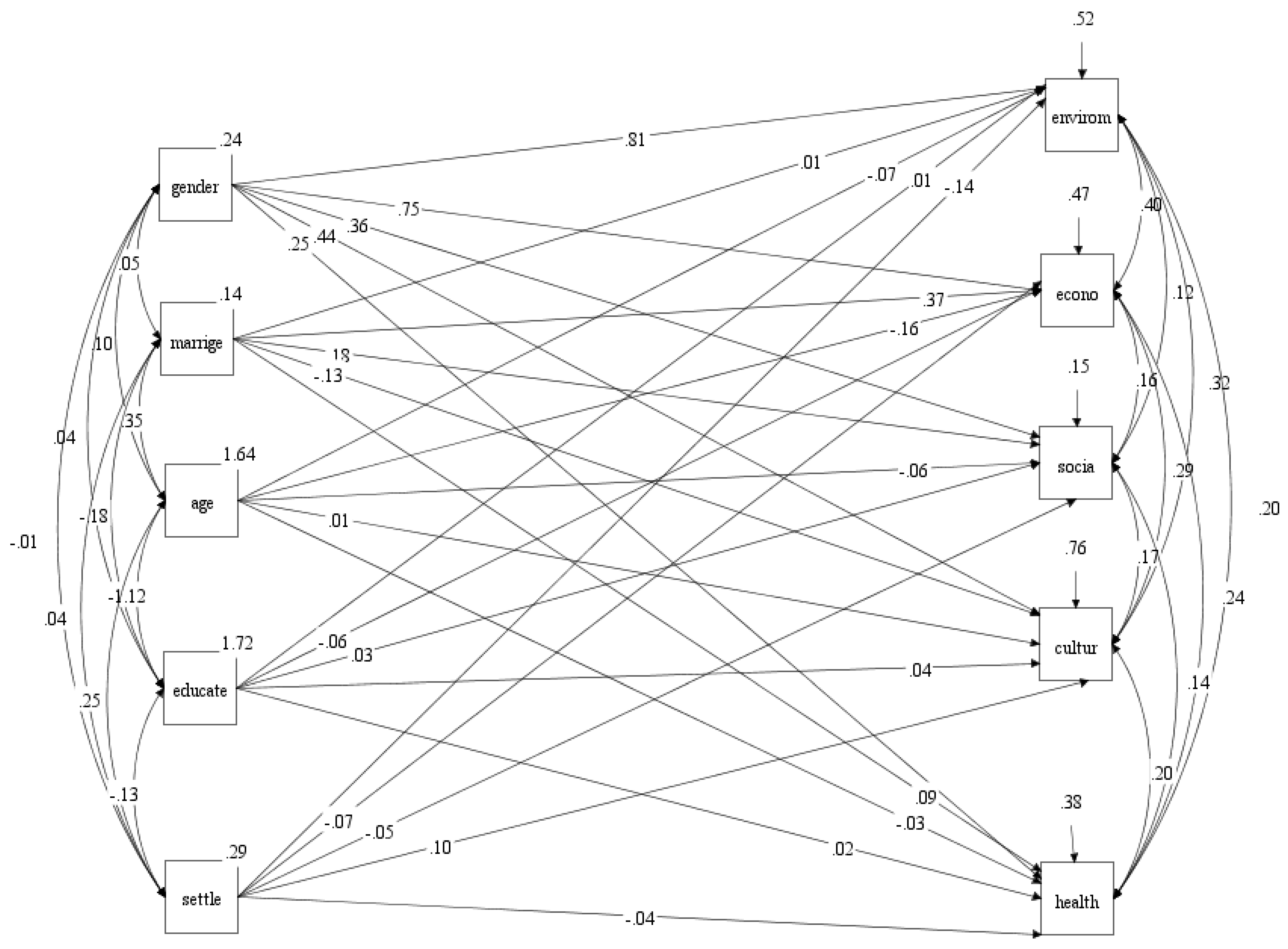
| Demographic Variables | Total | Percentage |
|---|---|---|
| Gender | ||
| Male | 9 | 75.00% |
| Female | 3 | 25.00% |
| Educational | ||
| Bachelor | 1 | 0.08% |
| Master | 6 | 50.00% |
| Doctoral | 5 | 42.00% |
| Experience in mine design | ||
| 5–15 years | 7 | 58.33% |
| >15 years | 5 | 41.67% |
| Variables | No. of Indicators | Cronbach’s Alpha Value |
|---|---|---|
| Environmental impact | Q1–Q17 | 0.78 |
| Economic impact | Q18–Q26 | 0.83 |
| Social impact | Q27–Q47 | 0.76 |
| Cultural impact | Q48–Q50 | 0.81 |
| Health impact | Q51–Q55 | 0.78 |
| N | Mean | Std. Deviation | Skewness | Kurtosis | |||
|---|---|---|---|---|---|---|---|
| Statistic | Statistic | Statistic | Statistic | Std. Error | Statistic | Std. Error | |
| Environment impact | 102 | 86.32 | 7.46 | −0.50 | 0.21 | −0.84 | 0.43 |
| Economic impact | 54.55 | 4.44 | −0.92 | 0.21 | 0.43 | 0.43 | |
| Social impact | 63.93 | 5.11 | −0.46 | 0.21 | −0.22 | 0.43 | |
| Cultural impact | 75.82 | 17.39 | −0.64 | 0.21 | −0.40 | 0.43 | |
| Health impact | 80.86 | 9.98 | −0.05 | 0.21 | −0.51 | 0.43 | |
| Hypothesis | β | p-Value | T-Value | Result | |
|---|---|---|---|---|---|
| Environment impact | Age | −0.076 | 0.521 | −0.64 | Accept |
| Gender | 0.768 | 0.013 | 2.49 | Reject | |
| Marriage | 0.008 | 0.977 | 0.02 | Accept | |
| Educate | 0.009 | 0.919 | 0.1 | Accept | |
| Residence record | −0.136 | 0.34 | −0.95 | Accept | |
| Economic impact | Age | −0.164 | 0.145 | −1.459 | Accept |
| Gender | 0.729 | 0.01 | 2.483 | Reject | |
| Marriage | 0.37 | 0.167 | 1.382 | Accept | |
| Educate | −0.062 | 0.447 | −0.761 | Accept | |
| Residence record | −0.065 | 0.631 | −0.481 | Accept | |
| Social impact | Age | −0.083 | 1.304 | 0.192 | Accept |
| Gender | 0.242 | 1.463 | 0.143 | Accept | |
| Marriage | 0.174 | 1.158 | 0.247 | Accept | |
| Educate | 0.01 | 0.212 | 0.832 | Accept | |
| Residence record | −0.049 | −0.637 | 0.524 | Accept | |
| Cultural impact | Age | −0.054 | −0.378 | 0.705 | Accept |
| Gender | 0.064 | 0.172 | 0.863 | Accept | |
| Marriage | −0.161 | −0.475 | 0.635 | Accept | |
| Educate | −0.016 | −0.158 | 0.875 | Accept | |
| Residence record | 0.089 | 0.517 | 0.605 | Accept | |
| Health impact | Age | −0.035 | 0.729 | −0.346 | Accept |
| Gender | 0.199 | 0.451 | 0.753 | Accept | |
| Marriage | 0.086 | 0.72 | 0.359 | Accept | |
| Educate | 0.008 | 0.911 | 0.112 | Accept | |
| Residence record | −0.04 | 0.743 | −0.328 | Accept |
Disclaimer/Publisher’s Note: The statements, opinions and data contained in all publications are solely those of the individual author(s) and contributor(s) and not of MDPI and/or the editor(s). MDPI and/or the editor(s) disclaim responsibility for any injury to people or property resulting from any ideas, methods, instructions or products referred to in the content. |
© 2023 by the authors. Licensee MDPI, Basel, Switzerland. This article is an open access article distributed under the terms and conditions of the Creative Commons Attribution (CC BY) license (https://creativecommons.org/licenses/by/4.0/).
Share and Cite
Dehghani, H.; Bascompta, M.; Khajevandi, A.A.; Farnia, K.A. A Mimic Model Approach for Impact Assessment of Mining Activities on Sustainable Development Indicators. Sustainability 2023, 15, 2688. https://doi.org/10.3390/su15032688
Dehghani H, Bascompta M, Khajevandi AA, Farnia KA. A Mimic Model Approach for Impact Assessment of Mining Activities on Sustainable Development Indicators. Sustainability. 2023; 15(3):2688. https://doi.org/10.3390/su15032688
Chicago/Turabian StyleDehghani, Hesam, Marc Bascompta, Ali Asghar Khajevandi, and Kiana Afshar Farnia. 2023. "A Mimic Model Approach for Impact Assessment of Mining Activities on Sustainable Development Indicators" Sustainability 15, no. 3: 2688. https://doi.org/10.3390/su15032688
APA StyleDehghani, H., Bascompta, M., Khajevandi, A. A., & Farnia, K. A. (2023). A Mimic Model Approach for Impact Assessment of Mining Activities on Sustainable Development Indicators. Sustainability, 15(3), 2688. https://doi.org/10.3390/su15032688







